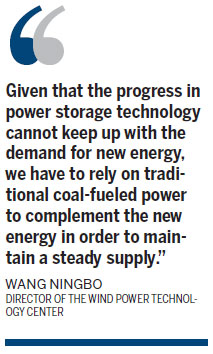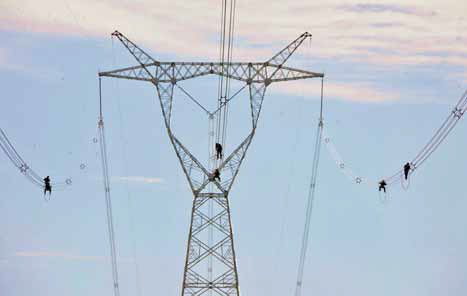Gansu powers up for sustainable futureUpdated: 2014-07-17 By Xue Chaohua ( China Daily ) Province is leveraging its advantages to generate a 10-million-kilowatt new energy base When speaking of Gansu province, what usually comes to mind is the Mogao Grottoes in Dunhuang, a World Cultural Heritage site on the Silk Road. Visitors are always amazed by the Buddhist wall paintings, which represent the pursuit of purity and enlightenment, at the ancient Buddhist complex. Yet today it is the blanket of shining solar panels and bustling wind turbines located along the ancient trade route, which are giving the province in Northwest China fame, as it has become the nation's new energy center. Wang Yunzhong, head of the plan and development department at Gansu Electric Power Co, told China Daily that together photovoltaic and wind energy now contribute one-third of the province's total power supply. And their contribution is expected to rise to around 40 percent at the end of this year, when a new 3-million-kilowatt wind power project is incorporated into the power network. "Our 10-million-kilowatt new energy base is already taking shape", Wang said. Gansu is one of the leading provinces for new energy, with photovoltaic installed capacity at 4.3 million kilowatts, which ranks first nationwide, and wind power installed capacity reaching 7.03 million kilowatts in 2013, the third highest, although it is expected to rise to second by the end of this year, Wang said. Wang Ningbo, director of the Wind Power Technology Center, said Gansu is rich in wind and solar energy resources, which are mainly clustered around the desert areas in the Hexi Corridor region. The potential wind power development capacity is estimated at 210 million kilowatts, and the potential photovoltaic power is predicted to hit 120 million kilowatts. In sharp contrast with the destructive wind force in some other wind-rich regions, which can be strong enough to destroy the turbines, the wind in Gansu is strong enough to work the turbines but not strong enough to destroy them and it is steady all the year around, Wang said. And the province is blessed with sunlight. Even in the worst part of the province, the solar energy generation is greater than that of most of East China, he noted. The Hexi area, in particular, is "extremely rich" in solar energy, which can compete with the Himalayas and the Qinghai-Tibet Plateau, he said. The province's vast land resources add another string to its new energy bow. "The new energy development requires a great deal of land," Wang said, adding that every 10,000 kilowatts of photovoltaic power need 33.3 hectares of solar panels. The land cost partially explains why it is less efficient to develop such an industry in crowded coastal and eastern regions of the country, he said. Environmental concerns also need to be taken into consideration, he added. In a wind farm, turbines themselves do not occupy much space, yet their effect extends farther. Wang cited one on an Inner Mongolian ranch as example, which is swamped with mice as their natural enemy hawks are driven away by the turbines. Thus the vast Hexi desert area in Gansu, which would otherwise be left as wasteland, is ideal to develop new energy industries, he said. Due to the nature of renewable energy, the supply of wind and solar power tends to fluctuate, he said. "Given that the progress in power storage technology cannot keep up with the demand for new energy, we have to rely on traditional coal-fueled power to complement the new energy in order to maintain a steady supply," he said. This is a common practice worldwide to ensure stable energy supply. Jing Qianming, chief of the control department at the company, said the new energy "is like a wild child, we have to learn to make him obedient". From the province's first four 300-kilowatt turbines imported from Canada in 1997 to the construction on the 10-million-kilowatt renewable energy base in 2013, heavy investment has been poured in to upgrade and expand the electricity grid. Like the highways that cannot accommodate heavy traffic and need updating, the grid also needs expansion to meet the demand, the company's executives said. At the same time, the company also values highly its innovation capacity and tries to sharpen an edge in technology. An R&D team headed by Wang Ningbo has participated in a national high-tech research program named "863" to conduct research into solar and wind power operation control. They are exploring ways to ensure the safety of new energy power generation and supply, and their efforts include developing smart grid control technologies. Compared with a wealth of new energy resources, the local market seems limited. Thus the company is seeking to expand outside the province. It has already linked its grid to those of the neighboring Shaanxi and Qinghai provinces and the Ningxia Hui and Xinjiang Uygur autonomous regions. Gansu is at the hub of the incorporated network, Director Wang said. Wang Yunzhong revealed that the National Development and Reform Commission is likely to give the green light to an extra-high voltage transmission line plan in August or September. Once it is approved, the 800-kilowatt passage will enable the power provision from Gansu to Hunan province in Central China in 2016, greatly helping ease the power tension in the region. xuechaohua@chinadaily.com.cn Steady wind throughout the year has enabled Gansu to become an ideal site for running wind power farms. Photos Provided to China Daily Workers with the Gansu Electric Power Co check wires to ensure the grid safety.


Gansu powers up for sustainable future
Editor:李莎宁
Source:中国日报网
Updated:2014-07-22 14:00:27
Source:中国日报网
Updated:2014-07-22 14:00:27
Special
Contact
Welcome to English Channel! Any suggestion, welcome.Tel:0731-82965627
lisl@rednet.cn
zhouqian@rednet.cn











